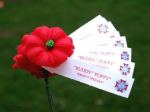This weekend marks the 100th Anniversary of the World War I poem “In Flanders Fields”. This poem was written by Canadian physician and poet Lieutenant Colonel John McCrae on May 3, 1915, as a tribute to his fallen friend, Alexis Helmer, who was killed at the Second Battle of Ypes. Canadian forces lost 5,975 men in this battle that marked the first use of poison gas by the German army.
According to legend, McCrae threw away the poem, but it was rescued from obscurity when fellow soldiers retrieved it from a wastebasket. The poem is popular as one of the memorial statements for WWI particularly in Canada. McCrae never returned home as he died of pneumonia near the end of the war.
The poem is written as a rondeau, a form of song that originated in France between the late 13th and the 15th centuries. The format has a fixed pattern with a refrain; the scansion is AB-aAab-AB, where “A” and “B” are the repeated refrain parts, and “a” and “b” the remaining verses:
-
In Flanders fields the poppies blow
Between the crosses, row on row,
That mark our place, and in the sky,
The larks, still bravely singing, fly,
Scarce heard amid the guns below.
We are the dead; short days ago
We lived, felt dawn, saw sunset glow,
Loved and were loved, and now we lie
In Flanders fields.
-
Take up our quarrel with the foe!
To you from failing hands we throw
The torch; be yours to hold it high!
If ye break faith with us who die
We shall not sleep, though poppies grow
In Flanders fields.
The poem was published in the British magazine Punch seven months later, and its references to the red poppies that grow on the fields of battle where soldiers fell gave rise to the “remembrance poppy.” Sales of remembrance poppies, usually made of silk, were used to fund war bonds, and after WWI, continued to be sold to fund veteran’s programs.
This past year (August-November 2014), a total of 888,246 ceramic kiln-fired remembrance poppies, hand formed by artists, were planted on the grounds of the Tower of London. Each of the poppies represented a British soldier killed during WWI.
The Tower Remembers Project website hosts videos on the creation of the poppies, which are the brainchild of artists Paul Cummins and Tom Piper.

888,246 poppies spill from the walls of the Tower of London; one for each British soldier killed in WWI.Paul Cummins
The exhibit called Blood Swept Lands and Seas of Red was installed at the Tower of London, in order to mark the one hundred year anniversary of Britain’s engagement in the First World War.
The ceramic poppies were sold and the proceeds split between six different charities, all associated with supporting veterans of war.
The poem also inspired the In Flanders Field Museum in Ypes, Belgium. In the museum, the poppies are on bracelets with imbedded RFID-chips that allow the wearer to read the personal stories about the war, filmed monologues and aerial photography.
Here in the United States, the American Legion adopted the poppy as their official symbol of remembrance in 1920 through the efforts of University of Georgia Professor Moina Michael.
The poem that McCrea wrote for a friend has inspired memorials to those who fought and died in World War I and all other wars as well. The poppy has been the torch, a way to “not break faith with us who die.”








